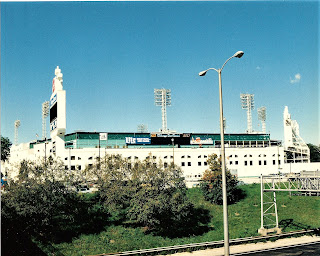If Major League Baseball starts a 2020 season, undoubtedly there will be no fans in the stands. No vendors, no ushers, very few security people and downsized team staffs. The White Sox played the Orioles in an empty Camden Yards (a few scouts were allowed in) on April 29, 2015, because of disturbances in Baltimore after the controversial death of Freddie Gray a few days earlier. The White Sox have played before some very small crowds throughout the years – official attendance numbers are useless as they don’t count the actual fans in the stands – and I attended one of them.
Comiskey Park, Sept. 30, 1990
Comiskey Park main entrance, Sept. 30, 1990
Those attending the 2015 game in Baltimore remarked about the ability to hear various sounds not audible during normal conditions. So it was with an almost empty house. We heard the umpires – most likely 3rd-base umpire Frank Umont – singing along with the National Anthem and the infield chatter. Some guys a few seats over were yelling at Sox 3rd baseman Don Buford, probably with racist crap, and Buford in turn traded insults.
Frank Umont, 1955 Bowman card
The pitchers were two of the game’s great: Whitey Ford for the Yankees and Tommy John for the White Sox. The Yankees defeated the Sox, 3-0, in what was Ford’s second-to-last MLB victory. Whitey pitched a complete game, yielding 7 hits, 2 strikeouts and 2 walks. John lasted 5 innings, giving up all 3 runs, 2 of which were unearned on an error by normally adept 1st-baseman Tommy McCraw. Chicago native Jim O’Toole and Wilbur Wood each hurled 2 innings of shutout, 1-hit baseball. Mickey Mantle, now a 1st baseman, went 0-5 on 3 groundouts and 2 flyouts, lowering his batting average to .100. He retired after the next season, in which I saw him play in my first game in Yankee Stadium.
Whitey Ford and Tommy John
The White Sox would contend in a four-team pennant race with the Red Sox, Tigers and Twins until the final week of the season. A doubleheader loss to the 10th-place Kansas City A’s, who had won 2 of their last 13 games, on September 27 was the near-death blow; a 1-0 loss to the Washington Senators (the run was scored in the 1st inning) two days later was the coup de grace.
Down to the Wire, an excellent book on the 1967 AL pennant race
Comiskey Park, Sept. 30, 1990
It’s anybody’s guess whether there will be a baseball season in 2020. One source says it will cost owners far less to cancel the season than to play a partial schedule and thus are making all sorts of ridiculous proposals, figuring the players union will reject them and be scapegoated for no baseball this season. If there is a season, I have one suggestion: no canned crowd noise. Back in the 50s, when the Sox were idle, WCFL would carry an out-of-town game with an announcer reading the play-by-play from a ticker-tape feed with a steady crowd soundtrack. I’m not that nostalgic.
















